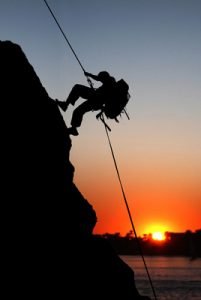Great strides have been made in the study of whole person healthcare. Integrating body, mind and spirit has become a key dimension of health education, prevention and treatment. Despite many advances in a wide range of holistic approaches, however, our health care system remains primarily disease-centered rather than focused on the well-being of the whole person.
Science has contributed to our understanding and treatment of disease. It has also limited the development of a model that honors personal relationships, emotions, meaning, and belief systems that connect body, mind, spirit, society, and nature. For increasing numbers of us, the biomedical model fails to offer a system for understanding the fullness of lived experiences—minimizing or negating completely the possibility for human transcendence in the face of illness and disease. Healing is more than curing; it is the restoration of wholeness.
A significant barrier to the integration of inner and outer approaches to reality is the seeming incongruity between, on the one hand, the worldview of physical science and, on the other hand, those of the spiritual traditions. As they are commonly conceived, religion and science are incompatible. But if properly understood and enlarged, these two realms may be incorporated within a framework that is at once true to their distinctions and yet comprehensive of both. In fact, it is leading us toward a kind of evidence-based spirituality that finds truth in different ways of knowing and being. It also offers a relationship-centered approach to health and healing.
Philosopher Franklin Merrell-Wolf (1994) captured the essence of this integral impulse in his conviction that “science, in the sense of knowing fully, cannot be restricted to objective material, but must, as well, be open to other possibilities of awareness.” Recognition that the scientific quest is incomplete without data from many domains of inquiry, and without various kinds of knowing, is fundamental to evolution that is occurring on individual and collective levels. It also offers a new map toward whole person healthcare.
Making use of an integral perspective makes it clear that our capacity to comprehend new possibilities for optimal health depends on a willingness to deliberately view together our physiological, emotional, cognitive, social, ecological, and spiritual processes. It also calls on us to ask crucial questions about the relationship between consciousness and the physical world, recognizing the interconnectedness of our thought, emotions, and bodies.
Integrating the Integral Model into Self-Healing
To thrive as individuals and members of diverse communities, we are called to develop an appreciation for the integral aspects, honoring both the inner wisdom of our direct personal experiences of illness and health, and for scientific and technological developments that may nourish the promotion of health and well-being. To gain insight into some of the basic tools that are used to practice integral or whole person healthcare, what follows is a series of twelve simple tools that you can use everyday.
– Examine your worldview. As you consider your life, work and relationships, recognize that you hold a unique worldview, belief system, and way of understanding what promotes whole person health for you. Your worldview offers a lens of perception from which you see everything. You bring your own beliefs and assumptions to self care. Diverse healing practices and approaches to wellness can add to the richness of your healthcare toolkit, but it can also add to the complexities as different approaches may come into conflict. Bringing awareness to these worldviews—your own and others—can aid you in your collaboration with your friends, family, and healthcare providers, many of whom may hold different views of health and healing. Stop long enough to reflect on your worldview, beliefs, stereotypes, and assumptions. How might they be limiting you or holding you back? How might they offer new ways to communicate with patients from diverse social and cultural backgrounds?
– Take an Integral Perspective. The integral model is based on an intuitive understanding of life and reality as an undivided whole. Seeing yourself and others as social, emotional, physical, and spiritual beings can allow for effective and meaningful communication that promotes healing and therapeutic relationships. Draw your attention to the four perspectives in the integral map: (1) the individual interior that includes personal and intentional dimensions, (2) the individual exterior, including behavioral and physiological dimensions, (3) collective interior, such as shared cultural meaning, and (4) the collective exterior, that involves the structures and systems in which health care operates. This integral map offers you an expanded awareness of the complexities of who and what you are in the fullness of your being.
– Develop healing relationships. Consider the importance of relationships, acknowledging the growth and support that these partnerships can bring to your life. In particular, focus on your relationship to yourself, making use of inner directed tools that allow you to access your own inner wisdom, including journaling, meditation, prayer, or connecting with nature. True healing can occur when you engage the healing power of relationships to your own inner wisdom.
– Healing wisdom comes through deep listening. Explore the profound process of listening, to others and to your own internal guidance system. Developing and growing these capacities, as a life practice, dramatically impacts your ability to be present and awake. As nurse leader, Janet Quinn once shared with me: “real healing is about so much more than the elimination of our signs and symptoms of disease.”
– Cultivate loving kindness. Many healers and spiritual masters note that the greatest source of healing in the world is love. Offering human to human, heart centered connections is at the core of healing at all levels of the integral model. Practicing loving kindness for yourself is as important as offering it to those you care about. Take a moment to define what loving kindness means to you and identify the ways you may nurture the tenderness and compassion of love in your daily routines.
– Model optimal health. Each one of us possesses an inner knowing of what we need to thrive and feel balanced, yet too often we don’t tend to our own needs. Finding time in each day to care for the integral nature of your life can provide you with the fullness of being a whole person. This includes nurturing your body, mind, spirit, and connections to others and the world around you. Taking time in nature, finding tools for reflection, getting exercise and eating well, are all ways in which you can maintain and model integral health for yourself and others.
– Develop a support system. Whether together or in virtual settings through social networking, connecting with others may offer you ways of living into new patterns or behaviors. Find or create social networks that support your explorations. Working in teams, participating in peer-to peer programs, developing common rituals and symbols to share with others, are but a few of many ways to connect, find support and share your interests in bringing consciousness to healing.
– Create healing rituals. Habitats for Healing is a program developed by Janet Quinn, PhD. In it, she invites us to approach little things we do every day as opportunities for healing rituals. We all wash our hands; she suggests that while running the water with mindfulness, bring healing intentions to yourself and others. Release any areas of stress or anxiety you are feeling. Invite in a model of centering and balance, even in the most hectic of circumstances. Use the water to help shed unwanted emotions that are disrupting your steady state.
– Set intentions for optimal healing. Ask yourself, “What matters most? What values do I want to adhere to?” Based on these reflections, you can craft an intentionality statement so that when challenges and opportunities arise, you will have developed an inner compass with which to navigate and make more conscious life choices. Setting intentions increases presence, attentiveness and effectiveness. Using affirmations will reinforce the intention.
– Stay informed. The internet is a great source of both information and confusion. Each of us comes to the health care environment with access to more information than ever before. Staying up to date and maintaining a curious and open mindset toward your own and your family’s health can benefit from the use of social media. But also remember to take time away from technology, cultivating the inner technology that can keep you grounded and feeling refreshed.
– Re-center yourself throughout the day. Remember to take a few deep breaths and center yourself in your own heart space. Learn from the wisdom of your heart, finding a sacred place within you. Offering gentle tenderness and open compassion to yourself can be a gift that will help nurture you and develop your own emotional and social skills.
– Death makes life possible. An important dimension of integral health and healing is recognizing the nature of your own mortality and that of everyone you love and care for. Reflect on your own views of death and what you believe happens after you die. There are many maps or worldviews on this matter, revealing a wide range of viewpoints. In considering them, you can find comfort and a set of possibilities for understanding your life. Through a variety of integral practices that begin with self reflection, look at the places where you experience fear and anxiety. Breath into these places, feeling your connection to the thread uniting every living being, throughout history. Find ways to transcend your suffering by living fully, each and every moment.
Marilyn Schlitz, Ph.D. is a social anthropologist, researcher, award winning writer, and charismatic public speaker. She serves as President Emeritus and a Senior Fellow at the Institute of Noetic Sciences. Additionally, she is a Senior Scientist at the California Pacific Medical Center, where she focuses on health and healing, and board member of Pacifica Graduate Institute. For more than three decades, Marilyn has been a leader in the field of consciousness studies. Her research and extensive publications focus on personal and social transformation, cultural pluralism, extended human capacities, and mind body medicine. She has a depth of leadership experience in government, business, and the not-for-profit sectors. Her broad and varied work has given her a unique ability to help individuals and organizations identify and develop personal and interpersonal skills and capacities needed by 21st century leaders. Her books include: Consciousness and Healing: Integral Approaches to Mind Body Medicine; Living Deeply: The Art and Science of Transformation in Everyday Life; and Death Makes Life Possible. She also wrote and produced a feature film, Death Makes Life Possible, with Deepak Chopra, that has appeared on the Oprah Winfrey Network. She is currently creating enrichment programs for life long learning and health professionals. https://marilynschlitz.com
Upcoming: “Living Deeply: Nine Steps to Healing and Transformation” on Friday, August 5th, 7:30-9:30 ($10-$20 sliding scale)
If you are like most of us, you sometimes struggle to find your personal compass. Engage with Marilyn Schlitz, PhD as she shares her evidence-based insights and practices to aid you in discovering new tools and resources to examine your assumptions and find your own internal guidance system.



